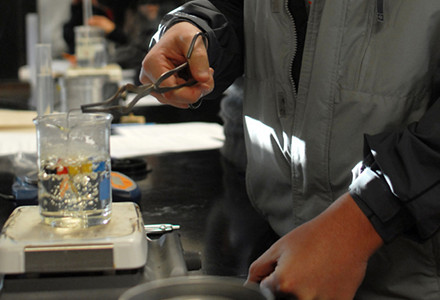Problem #5: How Much Energy Is That Anyway? — Units of Heat: Calories or joules consumed in a snack and used during exercise
Note: See all referenced files in the "Supplemental Files" section, at the end of this page.
Introduction
This introductory lesson requires students to convert between various units of energy (Calories, calories and joules) as they determine the energy released when they eat a snack and the energy used when they are active.
Learning outcomes
The students will:
- Understand that energy is released by the food we eat and used by our bodies.
- Convert between units of calories, Calories and joules.
- Relate and apply chemical principles to their life.
Curriculum alignment
NC SCOS GOAL 4.02 Analyze the law of conservation of energy, energy transformation, and various forms of energy involved in chemical and physical processes.
National Science Content Standard A: All students should develop an understanding of
- Abilities necessary to do scientific inquiry
- Understandings about scientific inquiry
National Science Content Standard B: All students should develop an understanding of
- Structure of atoms
- Structure and properties of matter
- Chemical reactions
- Motions and forces
- Conservation of energy and increase in disorder
Classroom time required
1 - 85 minute class periods
Materials needed
- How Much Energy Is That Anyway? Student Sheet (1 for each student)
- A variety of snack packs (1 per group) for the How Much Energy Is That Anyway? activity.
- Barium hydroxide and ammonium chloride for the endothermic demonstration as well as a small wood board (6” X 12”)
- Hot Hands or Toasty Toes for the exothermic demonstration ( 1 per class).
Technology resources
Student Pre-activities
Students should have an understanding of types of reactions and dimensional analysis.
Students should distinguish between heat and temperature
Teacher Pre-activities
- Ensure that there is a snack package with the nutrition label available for each lab group.
- Prepare the endothermic demo by gathering a 250 ml Erlenmeyer flask and placing 32 g of Ba(OH)2 8H2O g in the flask. Have 11 g of NH4Cl weighed on a piece of weigh paper. Have a piece of wood available to place the flask on.
Activities
- Review the difference between heat and temperature with a focus on heat as a form of energy.
- Lead into a discussion about the human body as a machine that requires energy and sources of that energy.
- Hand out the How Much Energy Is That Anyway? Activity and have students work in groups of 3 or 4 to complete the activity.
- Follow this activity with a class discussion that leads students to understand that food is the source of energy for our bodies. We use a tremendous amount of energy each day and so we require a significant amount of food as the fuel. Have students compare the joules of energy needed to run their car to those needed to run their body. You could base this on the same 10 mile distance that is given in question 3a of the conclusion.
- The following reaction, glucose + oxygen → carbon dioxide + water + energy, is just one example of how a reaction can produce energy. Ask the students if all reactions produce energy (Exothermic). Some will recognize that reactions can also require energy (Endothermic).
- Demonstrate an endothermic and an exothermic reaction to show that energy (heat) is involved in reactions other than digestion. Perform an endothermic demo (prepared prior to the start of class): Put water on the wood board. Add the ammonium chloride to the flask containing barium hydroxide prepared prior to class and swirl to mix. Walk around the room and ask students to comment on what they observe. They should notice that the 2 powders mix and begin to form a slurry and eventually a liquid. Allow students to touch the outside of the flask and describe how it feels to the class. The flask will become very cold and frost is sometimes visible. At this point, place the flask on the wet wood board and it will freeze to the wood within a minute. This is a very endothermic reaction. Heat is pulled from the water so that the temperature of the water drops below the freezing point. Follow this with a demonstration of hot hands which is an exothermic reaction. Write the equations for each of these reactions on the board. Students can help with formulas and balancing.
Heat + Ba(OH)2 + NH4Cl → NH3 + H2O + BaCl2
Fe + 3 O2 → 2 Fe2O3 + heat
Assessment
Complete the How Much Energy Is That Anyway? Activity.
Modifications
- When using the How Much Energy Is That Anyway? activity, the last question in the conclusion asks for their additional questions. These questions can be addressed in as much detail as time allows.
Critical vocabulary
- Calorie
- calorie
- Joule
- Enzyme
- Energy
- Thermochemistry
Comments:
purchased different snack packs for each lab group to discourage sharing of calculations between lab groups.
The Hot Hands or Toasty Toes can be purchased at a drug store or online. They are inexpensive, but not reusable so I use them as a demonstration. The directions are on the packet. The reaction is a simple oxidation of iron.
